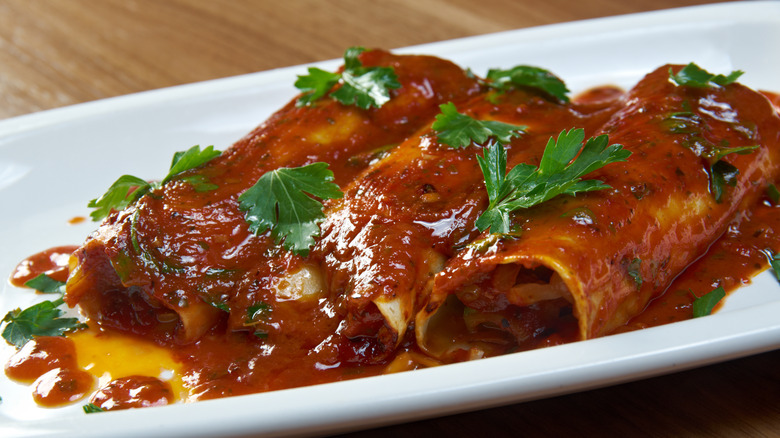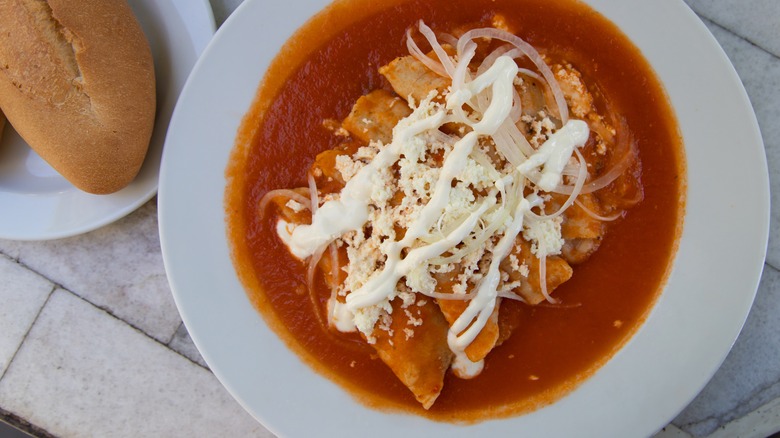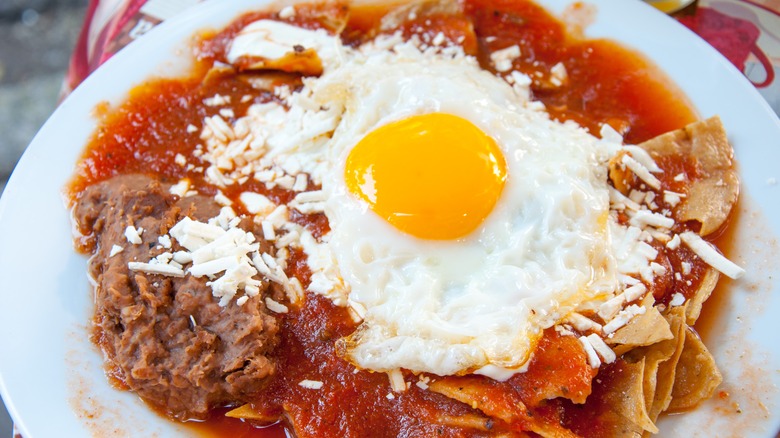The Difference Between Enchilada And Ranchero Sauces
Mexican and Tex-Mex foods are celebrated worldwide for their vibrant flavors and irresistible dishes. From spicy salsas to savory fillings, these culinary traditions never fail to captivate our taste buds. When exploring these cuisines, two popular sauces often come to mind: enchilada sauce and ranchero sauce. While both play significant roles in these styles, they possess characteristics that set them apart.
While there are exceptions to any rule, the split between these sauces falls on two elements: tomatoes and heat. Enchilada sauce is generally considered to be the milder of the two, running counter to the name, which is derived from the verb enchilar, meaning "to add chilis." Enchilada sauce is also much less dependent on tomatoes to drive the flavor, as the chilis and other aromatics steer this ship. Ranchero sauce, conversely, trends spicier, with tomatoes being an indispensable part of the recipe. This makes for a robust, acidic sauce that is deployed in slightly different ways than its chili-forward cousin.
What is enchilada sauce?
Enchiladas just wouldn't be complete without enchilada sauce. This distinct sauce typically calls for dried chili peppers, onions, garlic, spices, and, yes, occasionally tomatoes. The exact recipe may vary depending on the region and personal preferences, resulting in a range of flavor profiles. The chili peppers used can include ancho, guajillo, pasilla, morita, or a combination thereof, each lending its unique characteristics to the sauce.
As mentioned, one of the key roles of enchilada sauce is as a finishing touch to enchiladas, the famous rolled tortilla dish. After first lightly frying and filling the tortillas with ingredients like shredded poached chicken, carne picada, queso Oaxaca, or slow-cooked beans, they are rolled up and placed in a baking dish. The enchilada sauce is then generously poured over the enchiladas, coating them with its vibrant red color and infusing them with a burst of flavor.
However, enchilada sauce is not limited to enchiladas alone. Its versatility extends to various other applications in Mexican cuisine. It can be used as a marinade for meats, adding depth before grilling or roasting. It can serve as a dip for tortilla chips, offering a tangy, slightly sweet accompaniment. Additionally, enchilada sauce can be used as a topping for tamales, tostadas, and even as a base for soups and stews, infusing them with a tantalizing taste.
What is ranchero sauce?
Ranchero sauce, also known as salsa ranchera, originates from northern Mexico and has become an integral part of Mexican and Tex-Mex cuisines. It is typically made from a combination of tomatoes, onions, garlic, cilantro, and spices like cumin and oregano. However, what sets ranchero sauce apart is the use of hot, fresh chili peppers such as jalapeños or serranos, which infuse it with its characteristic heat.
This versatile sauce serves as a flavor enhancer in many dishes. The most obvious use of ranchero sauce is in huevos rancheros, a classic breakfast dish consisting of fried eggs served on tortillas and smothered with ranchero sauce. The sauce adds a fiery, vegetal kick to the rich, runny egg yolks. Ranchero sauce can be used to simmer meats, such as chicken or beef, infusing them with its bold flavors. Whether used in fajitas, burritos, or even enchiladas, ranchero sauce adds depth and spice to these Tex-Mex favorites.
The Venn diagram of ranchero sauce and enchilada sauce does have quite a bit of overlap, and the two can swap places if desired, but they are distinct, and each brings a unique character to the dishes they grace. It is important to think through when and how to use each, keeping in mind that it's always exciting to experiment in the kitchen. So, go ahead and ladle ranchero sauce on those enchiladas and make some huevos rancheros with enchilada sauce; it might just be your thing.


